In search of Roman sites near or along the Limes Trail of Germany
Posted on Nov 03, 2013 in category
Although not officially on the Upper Germanic-Rhaetian Limes wall which stretches for 550 kilometres, Ladenburg or Lopodunum was initially an early Roman auxiliary fort that guarded the Neckar River region between the Rhine and Danube Rivers. Prior to Vespasian's orders in c. AD 73-75 to establish a fort of timber and earth (3.9 hectares) at Lopodunum or Ladenburg, the Neckar region was a "debateable land" (Tacitus, Germania, 29) in which many Germanic tribes had tried to settle and dominate such as the Suebi, Helvetii, Boii, Santones and Cubii tribes.

In the above map, auxiliary forts established by Vespasian such as Ladenburg or Lopodunum are coloured in red with a green border; green boxes depict forts established by Emperors Domitian and Trajan; yellow boxes show forts along the limes set up in AD 2nd century; a large blue box depicts Mainz or Mogontiacum, a legionary fort and the smaller blue boxes are the earliest forts established by Claudius/Nero AD 40-68.
Lopodunum fort's relative isolation in an advanced 'No Man's Land' was short-lived for circa. AD 80 Emperor Titus pushed the frontier wall beyond the Neckar to the Danube River with new timber/earth forts established at Kosching, Eining, Regensburg and Straubing. His brother, Domitian, continued between AD 82-90 to strengthen the boundary or limes between the Roman frontier and the Germanic 'barbarians' by building, strengthening and linking forts as well as constructing more palisades, ditches and watchtowers (P.S. Wells, The Barbarians Speak- How the Conquered Peoples Shaped Roman Europe, Princeton, 2001, p93). Consolidation of the Roman limes or boundary (video in German but gives a good idea of recent archaeology!) continued under the prosperous times of Trajan, Hadrian and Antonius Pius (AD 98-161) with stone largely replacing timber walls.

Above are the foundations to the 'Porta Praetoria' or tower gateway (c.AD 90), its defences included a 17 metres wide gate.

An artist's interpretation of the impressive 2 passageway 'Porta Praetoria'.
About AD 100 Emperor Trajan changed the status of Lopodunum from a military post with its 'vicus' or surrounding indigenous settlement to a Roman town or 'civitas' called, 'Civitas Ulpia Sueborum Nicretum'. Lododunum continued to prosper as it was on a major trading road to Mainz as well as providing access to a major river, the Rhine via the 370 kms Neckar River. Like many German towns with a close proximity to the Roman military limes, Lopodunum responded positively to a big economic opportunity provided by the Roman military's demand for supplies such as leather goods, tools, weapons, textiles and, of course, food (P.S. Wells, "Creating an Imperial Frontier; Archaeology of the Formation of Rome's Danube Borderland," Journal of Archaeological Research, vol.13, no.1 March 2005, p.63). By AD 200 the town had grown to 44 hectares with defensive walls stretching 2.7 kms.

Evidence of a 'consumer revolution ' in Lopodunum is on display at Aalen Museum with a great range of ceramic vessels dated AD 74-100 including an amphora of wine from the Loire region of Gaul owned by a soldier named, 'Gaius Attius Augustalis'.

Lopodunum boasted a magnificient basilica and forum complex measuring 130 m. x 85 m. or 3,048 sq. metres. Today there are a couple of excavation sites that reveal this complex. Above are the remains of the basilica, first discovered in 1911, positioned just outside St Gallus Church which was built over most of the Gallo-Roman basilica's foundations. Between 1984-1987 Dr Sebastian Sommer discovered, excavated and conserved a section of the forum which can be visited in the basement of a modern building.

A wonderful conservation project- Ladenburg's Roman forum.
Recent archaeological research by Professor Eingartner revealed that the basilica was older than first thought. The 19 metres high structure was completed not in the 3rd century AD but earlier in the 2nd century AD. Also, it was thought to have used stilts in its construction but this was also proven to be an error in earlier archaeology.
Now for Ladenburg's piece de resistance, the Archaeological Museum.The main exhibit is the Jupiter/Juno votive offering column to the Imperial Cult - Emperor worship. A gift from a wealthy town patron, Novanius Augustus, the Jupiter/Juno column, that was found in 1975, also honours Minerva, Mercury and Hercules. It is broadly dated AD 170-260.

Apart from Roman deities, Lopodunum has evidence of worshipping local and foreign deities like Epona and Mithras respectively.

One of two statues of Epona, goddess of horses, displayed in Ladenburg's Archaeological Museum.
Further up the Neckar River, the town of Bad Wimpfen has a similar proud Roman history to Ladenburg. Under Domitian's orders, a small auxiliary fort was established (many of these small forts measured only 85m x 85m!) at Bad Wimpfen; unfortunately, the original name has been lost. In 1957 an oak beam from a former Gallo-Roman bridge was taken from the nearby Neckar River which verified a date of c. AD 85. Like Ladenburg, the military was reposted further inland c. AD 150-160 leaving a 'vicus' or neighbouring indigenous settlement that was renamed 'Civitas Alisin...[ensis}'. The town grew in size with a defensive wall of 1.9 kms enclosing 19 hectares.

The Neckar River viewed from the Blue Tower at Bad Wimpfen. The manager of the Blue Tower has raised her large family within this 13th century medieval tower (it was restored after lightning destroyed it in 1984!).

The monumental 'Blauer Turm' or Blue Tower of Bad Wimpfen.
Aalen was the largest auxiliary cavalry fort on the Raetian section of the Limes covering over 6 hectares. Established circa AD 160 towards the end of Emperor Hadrian or early Emperor Antonius Pius's rule , Aalen was soon to be dwarfed in importance in AD 179 by a legionary base at Regensburg or Castra Regina to the distant east of the Raetian Limes. Regensburg was bigger and more important as it was a legionary fort with 6,000 men on a 25 hectares site; however, Aalen was still a very important cavalry support fort situated along the most extended section of the Raetian Limes with some 1000 men from the Ala II Flavia Miliaria Pia Fidelis who were ready for swift action.

A roof tile made on site at Aalen by the 'Ala II Flavia miliiaria' (ALIIFL).
Moreover, Aalen commanded the route westwards down the Rems River valley, northward down the Kocher River heading towards the Neckar River as well as south to the Brenz and Danube Rivers.

Aalen also occupies a relatively central strategic position between the two legionary German forts of Mainz (Mogontiacum) and Regensburg (Castra Regina) both depicted by a large black square framed by a larger black square.
Today, Aalen Museum is part of a larger Archaeological Park that educates and entertains 45,000 visitors (35% are children). Constructed in 1964, the Museum battled construction companies for the rest of the site with the State deciding to take over the valuable site. In 1986 the 'principia' or company commander's headquarters was excavated. Originally its walls were18 metres high but only the stone foundations remain in situ.

A view of Aalen's 'principia' or commander's headquarters. An inscription details how Emperor Septimius Severus and his sons restored the run-down building and its capitolium or shrine in AD 208, 45 years or so after construction.
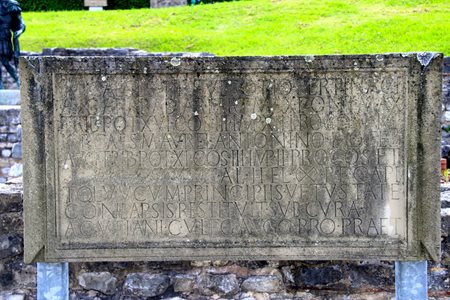
A replica of the famous restoration inscription.
Normally a high ranking equestrian, the second highest social rank in Roman society behind the patricians, would be in command. A shrine or 'aedes' would house statues of the emperor and his family as well as Rome's main deities. Also, the unit's standards would be placed here for safekeeping along with the strongbox holding the soldiers' hard-earned savings and wages. A bronze statue of Emperor Septimius Severus adorns the site of the former 'aedes' or shrine. Interestingly, an internet project, that aims to digitally collect and classify bronze Roman statue fragments from Germany's limes, has many examples from Aalen.
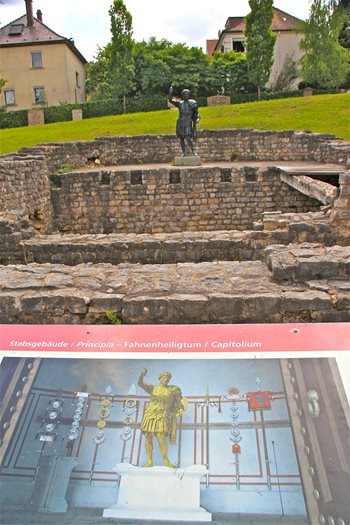
Good signage at Aalen gives the visitor a feel for the religious/political function of the 'principia' and its shrine. On a more practical level, the 'principia' possessed a clock that would serve an important military function - provide time for the day and night watch duties!
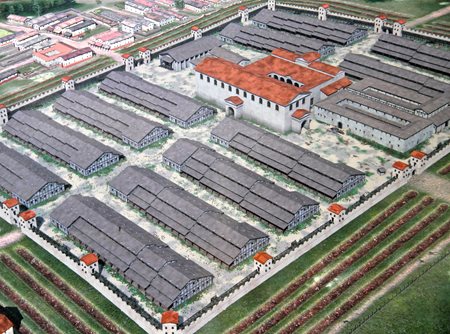
An artist's interpretation of Aalen fort with the white-washed principia in the middle but with a courtyard that led to what many archaeologists believe to be a cavalry drill hall.

An enormous cavalry drill hall must have served an important function judging by the size and central location of the building. Can you see the lonely figure on photo duty standing in the back gateway of the drill hall?

Another perspective on the size of this great drill hall.
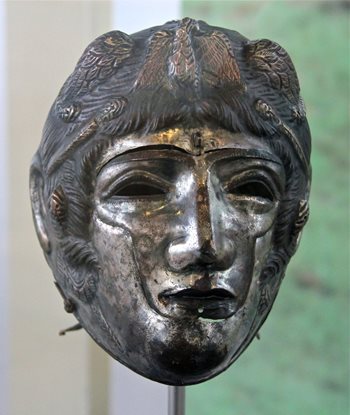
A replica of a ceremonial cavalry parade mask (2nd/3rd centuries) excavated near Tubingen at Nagold-Pfrondorf.
Only about 1/3 of the original 6 hectares site at Aalen has been excavated. The Museum was renovated again in 1999 and the permanent exhibition redesigned to include not only military history and life but also life in the 'vicus' and the surrounding agricultural and limes region.

100 remnants of leather shoes in 4 styles were found in wells no.1 and 2 (total of 4 wells) at Welzheim Eastern fort near Aalen. Welzheim had both an eastern and western fort with another small fort closeby at Rotelsee.

Gambling was a common pastime and problem in Roman forts, This Aalen Museum display of dice and games tokens was excavated from several forts along the Limes frontier such as Kongen, Bobingen, Schwabisch Gmund, Ingelheim-Greilsbach and Rainau-Buch (Aalen Museum). Tellingly, a stone gaming board found in a catacomb in Rome was inscribed with:
'Parthi ocisi/ Br[i]tt[o] victus/ludit[e R]omani'
'Parthians slaughtered, Briton conquered, Romans play'
- taken from L. Keppie's , Understanding Roman Inscriptions, (Maryland 1991) p.118
Another Gallo-Roman settlement of interest in southern Bavaria is Kempten or 'Cambodunum'. Founded at the beginning of 1st century AD (either towards the end of the Augustan principate or beginning of Tiberius' rule), Kempten soon became the main Gallo-Roman garrison/settlement in the Allgau or southern German Alps region. Its predominance lasted until the beginning of the 2nd century AD when the capital of Raetia was moved to Augsburg or Augusta Vindelicum.

Cambodunum's prosperity in the 1st century AD is evident in the above imported Italian glassware (Archaologische Staatssammlung, Munich).
The first monumental building constructions began in Kempten during Claudius' principate c. AD 50; however, it was only after the town's destruction which was a result of the civil wars of succession following the suicide of Nero in AD 68, that new and grander public building constructions began. Proof of 'Civitas' pride (and possibly, 'municipium' pride - 2nd cent AD)) is evident in the forum with temple, curia and a basilica (47 m x 23.5 m), a large bathhouse measuring 75 m x 75 m and two other bathhouses.

A special feature of Kempten is the discovery of a large, enclosed sacred precinct (238 m x 178 m)- 'Galloromischer Tempelbezirk'. Some 13 timber shrines were built around AD 50 with the upgrading and expansion of shrines in stone in 2nd century AD. Another two temples near the forum have been discovered although there is no indication of what deities were worshipped in them.

The round 'fire altar' used for offerings to the gods. The temple to Hercules (2nd cdentury AD) is the large temple in the background. A funerary stone inscription stated:
"In honorem
Domus Divinae
Herculem
Colentes"
In honour of
the divinely (Imperial) house,
the devotees of Hercules
(A list of cult devotees' names followed this dedication)

A citizen of Cambodunum, Florus, son of Dullavius, dedicated this altar stone, within the sacred precinct, to the Gallo-Roman goddess, Epona.

Another view of the sacred precinct with a temple dedicated to the very popular Gallo-Roman deity, Mercury, god of commerce (on the far right).

A superbly conserved 'Large Bath' complex with the round steam or sauna room ( 'sudatorium-laconicum') in the foreground, followed by the cold room ('frigidarium' ) as well as a rectangular pool (piscina') on the far right.

The photo above this plan was taken from the position of the red dot.
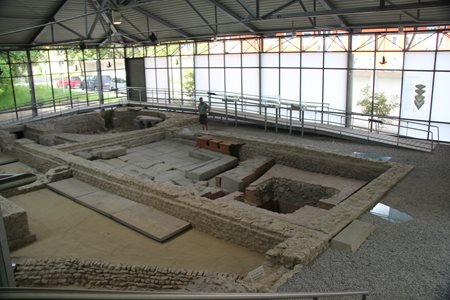
A very substantial latrine facility was provided for patrons of the baths and passers-by.

Lead clothing labels found in the 1990's in the 'palaestra' or athletics ground (far left) and the small bath (far right).

Few archaeological finds remain of the forum. An open park area and a bronze model of the forum (far left) helps visitors to visualise the forum's glorious past albeit the model is a little worse for wear exposed to the elements. Kempten's Archaeological Park may be a little spread out for some tourists but the walk gives visitors a good guide to Cambodunum's size and civic grandeur and it is an enjoyable way to spend a morning!
Augsburg or Augusta Vindelicum was originally a military base of 10-12 hectares sited on the confluence of the Lech and Wertach Rivers. It was established most likely c. 8 BC -AD17. A gravel pit discovery in 1913 measuring 30m x 3m harvested about 10,000 artefacts including 378 coins allowed the above dating range. Under Emperor Claudius (AD 41-54), Augsburg received a big boost in status as it now became the capital of the new province, Raetia; thus, the seat of the 'legatus August, pro praetore'. Subsequently, Augsburg became a rare German 'municipium' by Emperor Hadrian c. AD 121.

Augsburg was strategically located on the Via Claudia.
According to P.S.Wells, The Barbarians Speak, (New Jersey, 1999) pp. 174-175, the city's walls (constructed later circa. AD 170-180) enclosed a substantial 65 hectares . Nero's decline in AD 68 saw Augsburg's destruction. However, the city's silver lining came quickly as a new forum of 9,400 sq metres was developed along with 3 public baths, a curia, basilica, a 'macellum' or market place 172..5m x 44.5 m 9 (a similar size to Pompeii's building) and temples to Mars/Victory, Sol (a Mythraic god), Elagabal (a Syrian sun god) and Isis (Egyptian goddess of magic, rebirth and reincarnation).

Remnants of a once great forum next to Augsburg's 13th century AD Gothic Cathedral. On the far left background, visitors can inspect the foundations of the Church of St. John (AD 10th century) and a section of the city's original Roman defence walls. On the right, funerary gravestones include a former Augustale priest (Imperial Cult), Marcus Aurelius Carus and Julius Avitus Alexianus, husband of Julia Maesa (Sun god cult).

Augsburg is proud of its Roman heritage as witnessed by this bronze fountain dedicated to Augustus and other classically inspired sculptures in the CBD area. The magnificently restored Rathaus (bombed during WW11) has a tribute to Roman Emperors with a series of bronze busts decorating its main staircase to the Great Hall.
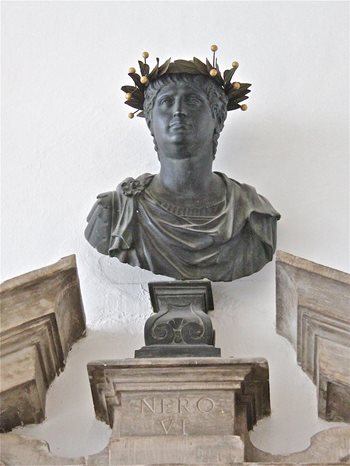
On Nero's demise, the Year of the Three Emperors AD 68, saw many towns in Raetia such as Augsburg destroyed by supporting the losing pretender to the 'princeps' or emperor.

Another classical allusion in the superbly restored Rathaus in Augsburg's Great Hall - Julius Caesar's commentary,
'I came, I saw, I conquered!'
Despite Caesar's boast, it is worth remembering that Celtic culture did not suddenly die out with the imposition of the new Roman regime in the German provinces. Dynamic changes did occur but a new Gallo-Roman culture emerged, a blend of both new and old. A good example of a proud Celtic culture coexisting with 'romanitas' was discovered near Munich (Munchener Schotterebene area). The 'Heimstettener Gruppe' of artefacts dated AD 20-60 are inhumation grave goods (Roman tradition at this time was for cremation!) which reveal the continuation of Celtic culture regardless of Roman rule.

Roman-styled, bronze fibulae with Celtic designs such as the wheel were worn by these Alpine people as well as traditional neckrings (Archaologische Staatssammlung, Munich).

It is thought that the Celtic people, who wore belts like the one above and who lived around the Lech/Isar Rivers in southern Bavaria, came originally from the Alpine-Piedmont region (Archaologische Staatssammlung, Munich).